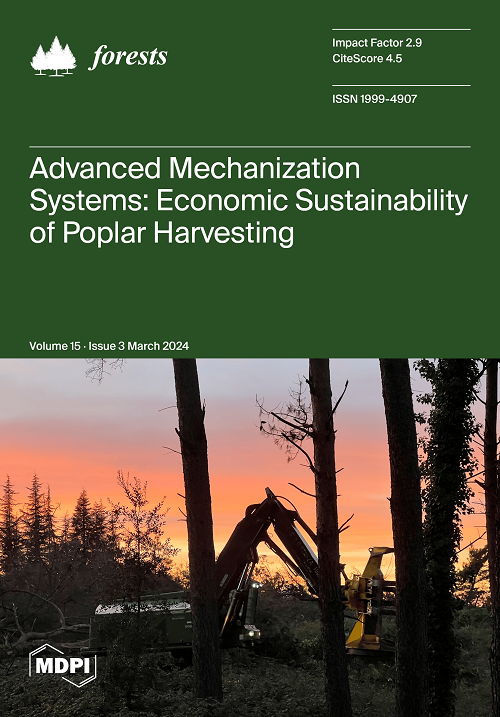Estimation of Carbon and Nitrogen Contents in Forest Ecosystems in the Background Areas of the Russian Arctic (Murmansk Region)
IF 2.5
2区 农林科学
Q1 FORESTRY
引用次数: 0
Abstract
In this study, carbon and nitrogen contents in the undisturbed terrestrial ecosystems in the northern taiga zone of Russia’s Murmansk region were estimated. The goal of this study was to examine the carbon and nitrogen dynamics in atmospheric precipitation, assimilating organs of coniferous trees (Picea obovata and Pinus sylvestris), needle litter, soils, and soil water. The objects of our research were the most common dwarf shrub-green moss spruce forests and lichen-dwarf shrub pine forests of the boreal zone. The study was carried out on permanent plots between 1999 and 2020. The long-term dynamics of carbon concentrations in snow demonstrated a trend towards increasing carbon concentrations in forested and treeless areas of the Murmansk region. It was shown that in representative spruce and pine forests, the concentrations and atmospheric precipitation of carbon compounds and carbon leaching with soil water were higher below the tree crowns, compared to between the crowns. In soil water, a decrease was found in carbon concentration with the soil profile depth. For soils, the highest carbon concentrations were found in the organic and illuvial soil horizons. The main soil sinks of carbon and nitrogen in northern taiga forests were found to be located in the organic soil horizon below the crowns. In northern taiga forests, the carbon content of living Picea obovata and Pinus sylvestris needles and Pinus sylvestris needle litter had minor variability; no significant interbiogeocoenotic and age differences were found. We found that the nitrogen content in brown needles and needle litter was significantly lower compared to photosynthetically active needles, probably due to retranslocation processes (withdrawal before needle abscission), corroborating the literature in the results session. The largest stocks of carbon and nitrogen in northern taiga forests are concentrated in the soil organic horizon, and the removal of these elements with soil water is insignificant. Carbon and nitrogen stocks in living and fallen needles are lower than in soil. The least amount of carbon and nitrogen is contained in atmospheric precipitation.俄罗斯北极背景地区(摩尔曼斯克地区)森林生态系统的碳和氮含量估算
本研究估算了俄罗斯摩尔曼斯克地区北部泰加地带未受干扰的陆地生态系统中的碳和氮含量。这项研究的目的是考察大气降水、针叶树(Picea obovata 和 Pinus sylvestris)同化器官、针叶落叶、土壤和土壤水中的碳氮动态。我们的研究对象是北方地区最常见的矮灌木绿苔云杉林和地衣矮灌木松林。研究于 1999 年至 2020 年期间在永久性地块上进行。雪中碳浓度的长期动态变化表明,摩尔曼斯克地区有林地区和无林地区的碳浓度呈上升趋势。研究表明,在具有代表性的云杉林和松树林中,树冠下方的碳化合物浓度和大气降水量以及土壤水的碳浸出量均高于树冠之间。在土壤水中,碳浓度随着土壤剖面深度的增加而降低。在土壤中,有机层和冲积层土壤中的碳浓度最高。在北部泰加森林中,碳和氮的主要土壤汇位于树冠下的有机土壤层。在北泰加森林中,活体针叶松和针叶松针叶落叶的碳含量变化较小;未发现明显的生物地理群落间差异和年龄差异。我们发现,与光合作用活跃的针叶相比,棕色针叶和针叶落叶中的氮含量明显较低,这可能是由于再转移过程(针叶脱落前的抽出)造成的,这与成果会议上的文献相吻合。泰加北部森林中最大的碳和氮储量集中在土壤有机层中,土壤水对这些元素的清除作用微乎其微。活针叶和落叶针叶中的碳和氮储量低于土壤中的碳和氮储量。大气降水中的碳和氮含量最少。
本文章由计算机程序翻译,如有差异,请以英文原文为准。
求助全文
约1分钟内获得全文
求助全文
来源期刊

Forests
FORESTRY-
CiteScore
4.40
自引率
17.20%
发文量
1823
审稿时长
19.02 days
期刊介绍:
Forests (ISSN 1999-4907) is an international and cross-disciplinary scholarly journal of forestry and forest ecology. It publishes research papers, short communications and review papers. There is no restriction on the length of the papers. Our aim is to encourage scientists to publish their experimental and theoretical research in as much detail as possible. Full experimental and/or methodical details must be provided for research articles.
 求助内容:
求助内容: 应助结果提醒方式:
应助结果提醒方式:


